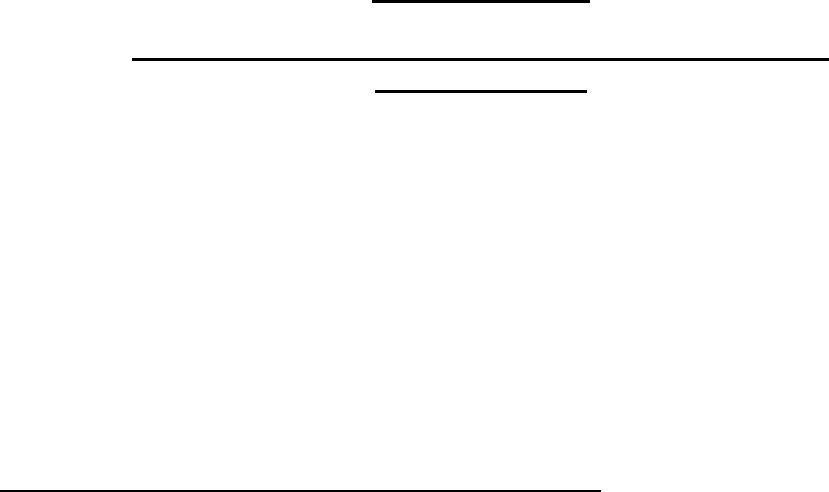
COUNTY OF LOS ANGELES
DEPARTMENT OF PUBLIC WORKS
ENVIRONMENTAL PROGRAMS DIVISION
900 South Fremont Avenue, 3
rd
Floor Annex, Alhambra, CA 91803
Attachment 1 – Methane Barrier Test Criteria
METHANE AND OTHER SOIL VAPOR GAS BARRIER
CERTIFICATION CRITERIA
REQUIREMENTS FOR CERTIFICATION OF PRODUCTS ELIGIBLE FOR USE
IN SOIL VAPOR MITIGATION AND METHANE GAS MIGRATION
BARRIER IN ENCLOSED STRUCTURES AND BUILDINGS
1. Provide a report detailing a description of the material/product including
manufacturer’s specifications which demonstrates each requirement in the
attached gas barrier test criteria has been satisfied.
2. A summary of historical monitoring (minimum four years) showing the history of
performance and durability of the methane gas barrier product (product) in
passive gas control systems. This summary must include concentration of
methane gas above and below the product in percent volume in air.
3. A failure analysis, including but not limited to, identification of all locations where
the product has been unsuccessful as a methane gas barrier and where there is
leakage or detection of methane gas above the membrane, specific reasons for
the leaks and/or failure of the product at the site and a description of the methods
of remedy applied.
4. In addition to the laboratory data provided, the influence of burial of the product
under load conditions must be addressed. This includes, but is not limited to,
differential settlement, axial load, etc. Also, the effect of aging under burial
conditions must be provided.
5. Landfill gas is a combination of gases, such as, H2s, N2, H2, 02, volatile organic
compounds, carbon monoxide, methane gas, etc. The long-term effect of these
gases on the product must be analyzed and submitted to this Department. In
addition, the membrane may also be subject to various petroleum hydrocarbon
elements, such as, benzene, toluene, and xylene. The long-term effect of these
elements on the product must be analyzed and submitted to this department.
(Test @20,000 ppm, result must be below 1% weight change).
6. In order for us to proceed, the applicant must deposit $5000 cash in order to
compensate Public Works of all expenses incurred related to administration of
this evaluation, including overhead costs.
7. NOTE: A 5-yearly re-certification of product listing on the LA County Approved
Material List will be conducted to ensure the product use is sustainable and still
viable for its approved designated use. There will be a deposit of $1,000 cash to
compensate Public Works of all expenses incurred for the recertification
process.

COUNTY OF LOS ANGELES
DEPARTMENT OF PUBLIC WORKS
ENVIRONMENTAL PROGRAMS DIVISION
900 South Fremont Avenue, 3
rd
Floor Annex, Alhambra, CA 91803
Attachment 1 – Methane Barrier Test Criteria
Any product which fails the recertification audit will be delisted from the County’s
Approved List of Product for methane or soil vapor barrier use for areas within
the County’s jurisdiction.

ATTACHMENT 1
METHANE AND OTHER SOIL VAPOR GAS BARRIER
TEST CRITERIA
PART 1 - BONDED SEAM STRENGTH TESTS:
A. Seams shall be bonded using processes and materials representative of the field installation.
The method of producing the seams that was used to pass this criterion shall be the only
method approved for field installation.
B. A minimum of ten identically prepared specimens shall be tested.
C. Unsupported materials
1. Method A or B of ASTM D882-10 shall be used with the following modifications:
a. Specimens shall be 1 inch wide.
b. The grip separation shall be 4 inches plus the width of the seam with the seam
centered between the clamps and oriented perpendicular to the length of the test
specimen.
c. The rate of the grip separation shall be 20 inches per minute or as specified in the
material property tables. The rate of grip separation for HDPE liners shall be 2
inches per minute.
d. Conditioning of the sample seams shall be as described in Part E.
D. Supported Materials
1. The Grab Test method of ASTM D751-06 shall be used with the following
modifications:
a. Specimens shall be 4 inches in width and not less than 9 inches
plus width of the seam.
b. At the start of the test the sample shall be positioned such that the clamps
are 3 inches clear from the closest edge of the seam.
c. Conditioning of the sample seams shall be as described in Part E of this
test criterion.
d. The rate of loading shall be at the rate of 12 inches per minute.
E. Conditioning of seam specimens
1. Heat-sealed specimens shall be conditioned for 24 hours at 74 + 4 degrees
Fahrenheit. (23 ± degrees C).
2. Adhesive seamed specimens shall be conditioned for a minimum of 24 hours at
74 + 4 degrees Fahrenheit (23 ± 2 degrees C), or for any greater period of time as
recommended by the manufacturer. The test report shall state the time period
used for conditioning of the test samples.
Page 1 of 6

ATTACHMENT 1
METHANE AND OTHER SOIL VAPOR GAS BARRIER
TEST CRITERIA
Methane Barrier Test Criteria
F. Seams and bonding methods shall be deemed acceptable when none of the ten samples
fail within the bonded overlapping portion of the test samples, such that the seams may
be deemed as strong as or stronger than the membrane as tested without seams.
G. The test report shall include the additional information as needed to specify the test
seam. The length of the overlap, method of bonding the seam, and, if a bonding agent is
used, the rate of dispersion of the bonding agent and curing time used to produce the test
samples shall be reported.
Note that this test shall apply to liquid applied membranes also. Samples representative
of the manufacturers recommended field repair guidelines shall be tested.
PART 2- MICROORGANISM RESISTANCE (SOIL BURIAL)
A. Testing shall be performed according to Annex A1 of ASTM D4068-09 with the
following changes:
1. Section A 1.2.1 is modified by omitting the three T-peel specimens and replacing
them with two sets of five samples of appropriate dimensions as needed to test
the Bonded Seam Strength in accordance with Part 1 of this test criteria for
methane barriers. In addition, a minimum of two sets of three specimens of the
size needed to perform the methane gas permeability test according to ASTM
D1434-82(2009) e1 shall be prepared.
2. Section A 1.3.3.1 shall be modified by substituting Bonded Seam Strength
specimens for the T-peel specimens.
3. Section A 1.4.1 is amended by adding the requirement that both sets of the
samples needed for testing Bonded Seam Strength and Methane Permeability be
buried as prescribed in this section.
4. Section A 1.4.2 is amended by omitting the test requirement for the T-peel
samples.
5. Section A 1.4.3 is amended by omitting the test requirement for the T-peel
samples, and by adding the requirement that one set of the buried samples for
Bonded Seam Strength and Methane Permeability be tested as prescribed in Parts
1 and 3 of this acceptance criteria. The second set of the Bonded Seam Strength
and Methane Permeability shall be retained for future reference.
B. Acceptable materials must exhibit the following performance characteristics:
1. The average value of weight change ± 5%.
2. The average value of tensile strength change ± 10% maximum.
3. The average value of tensile stress at 100% elongation ± 10% maximum.
Page 2 of 6

ATTACHMENT 1
METHANE AND OTHER SOIL VAPOR GAS BARRIER
TEST CRITERIA
Methane Barrier Test Criteria
4. The average value of elongation change ± 10% maximum.
5. Bonded Seams shall not fail in the seam areas when tested to criteria of Part 1.
6. Methane Permeability shall neither increase beyond the values obtained from
Part 3 nor shall they exceed the limit stated in Part 3 of this test criterion.
PART 3- METHANE PERMEABILITY
A. Methane Permeability shall be tested using ASTM D 1434-82(2009) e1 with the
following added requirements:
1. Testing shall be performed at a temperature of 74 ± 4 degrees
Fahrenheit. (23 ± 2 degrees C)
2. A minimum of 3 samples shall be tested and the average value of the Methane
Gas Transmission Rate shall be reported. If the lower test value varies by more
than 10% from the highest test value two additional samples shall be tested, and
the Gas Transmission Rate shall be reported as an average of the five test values.
B. Materials exhibiting an average Methane Gas Transmission Rate not exceeding
40.0 ml/day.m
2
.atm shall be acceptable.
PART 4- OIL RESISTANCE TEST
A. Testing shall be performed according to ASTM D543-06 with the following
specifications:
1. Section 10.2 is clarified to specify that the tests shall be run at a temperature of
74 ± 4 degrees Fahrenheit. (23 ± 2 degrees C)
2. Section 10.4 shall be modified to require the test to be run for 28 days.
3. To Section 7 of this standard add the following test specimen requirement:
Bonded Seam Strength Specimens shall be prepared in accordance to the
guidelines of Part 1 of these standards. Five specimens shall be immersed in the
test reagent and tested to failure as specified in the Bonded Seam Strength test
criteria.
B. The following reagent shall be used:
1. Standard 30 weight non-detergent motor oil.
C. Materials will be judged acceptable if the average value of changes do not exceed:
1. Weight change 10%.
Page 3 of 6

ATTACHMENT 1
METHANE AND OTHER SOIL VAPOR GAS BARRIER
TEST CRITERIA
Methane Barrier Test Criteria
2. Tensile yield strength + 10%.
3. Tensile breaking strength ± 10%.
4. Elongation at break ± 10%.
5. Testing of Bonded Seams shall not exhibit any failure in the bonded seams.
PART 5- HEAT AGING
A. Heat aging shall be tested in accordance with ASTM D4068-09 with the following
modifications:
1. Section 14.3 is modified to omit the weight change specimens and bonded T-peel
specimens. This section is further amended to require five Bonded Seam Strength
specimens of dimensions needed for testing in accordance with Part 1 of this
acceptance criterion to be heat aged.
B. Tensile strength, tensile stress at 100% elongation, and ultimate elongation shall be tested
per Section 14.1 and compared to unconditioned samples.
C. Bonded Seam Strength specimens shall be tested in accordance with the procedures
outlined in Part 1 of this acceptance criterion.
D. Acceptable performance is obtained when the following is obtained:
1. No Bonded Seam Strength Samples shall fail in the seam locations.
2. The average values of the tensile strength change ± 10% maximum.
3. The average value of the tensile stress at 100% elongation ± 10% maximum.
4. The average value of the elongation at break ± 10% maximum.
E. Liquid applied membranes shall use specimens representative of the field repair method
recommended by the manufacturer for the Bonded Seam Strength Samples.
PART 6- DEAD LOAD SEAM STRENGTH
A. Scope
To determine the ability of factory seam joints to withstand stress under load at
room Temperature (72 + 4 degrees F).
Page 4 of 6

ATTACHMENT 1
METHANE AND OTHER SOIL VAPOR GAS BARRIER
TEST CRITERIA
Methane Barrier Test Criteria
B. Test Specimens
The supported specimen size shall be 4-inch width of the seam joint and a 12-inch length,
sufficient to fit in the clamps of the testing machine. The unsupported specimen size shall
be 1-inch width of the seam joint and an 8-inch length. A total of five specimens shall be
tested.
C. Procedure
The clamping mechanism will grip a 1-inch wide section and should be centered in the
width of the test specimen, above and below the seam joint. The clamps shall not grip
any portion of the overlap area of the seam joint.
1. Room Temperature Test: A load equivalent to 50% of the materials value for
tensile stress at 100% elongation (modulus) shall be applied at the seam joint.
The load shall be maintained for 4 hours at a temperature of 72 ± 4 degrees F.
The stressed sample must be closely observed. Excessive elongation may require
clamp adjustment to maintain consistent loading. When elongation reaches 50%
of the original jaw separation. No additional adjustment need be made. Retain
existing load for balance of test duration.
2. A "failure" will be noted when seam joint separates entirely.
D. Reporting of Results
The results shall be reported by indicating the designated load, the temperature, the time
duration of the test, the length of the overlap seam, and a "pass” or "fail" designation.
E. Seams shall be deemed acceptable when none of the five specimens fail.
PART 7- ENVIRONMENTAL STRESS-CRACKING
A. Testing shall be performed using Condition B of ASTM D1693-08 with using the
following modifications:
1. Use an aqueous solution containing 10% igepal by volume.
2. The final product shall be tested as produced, regardless of thickness.
3. The notch depth shall be as stated in Condition B (0.12 to 0.15 in.) for all sheet
thicknesses.
4. Cut five specimens with the length parallel to the roll direction (MD) and five
with the length parallel to the cross-roll direction (TD).
5. Failure time shall be the time in hours to the first specimen failure.
B. The material will be deemed acceptable when the time to first failure exceed 500 hours.
Page 5 of 6

ATTACHMENT 1
METHANE AND OTHER SOIL VAPOR GAS BARRIER
TEST CRITERIA
THIS PAGE INTENTIONALLY LEFT BLANK
